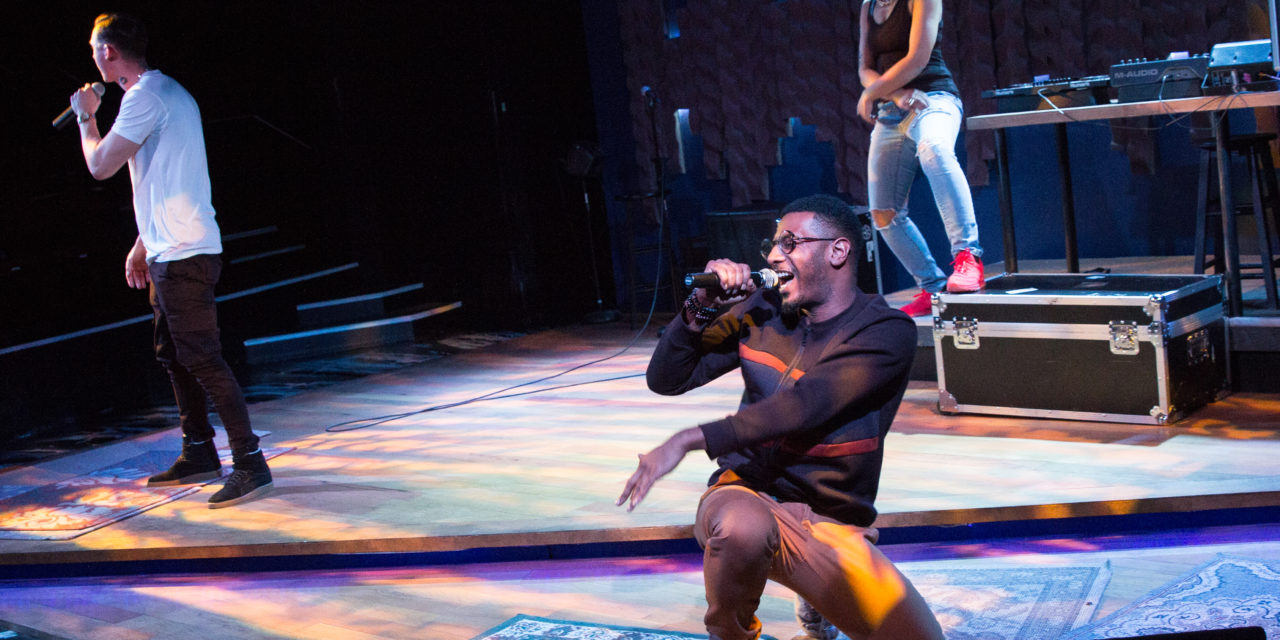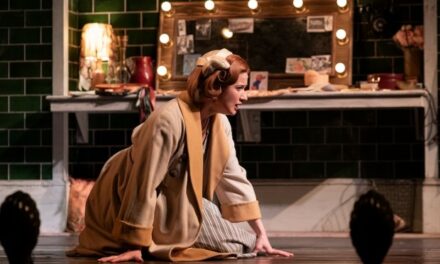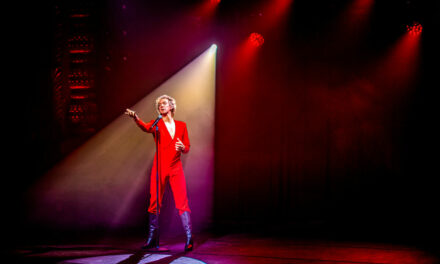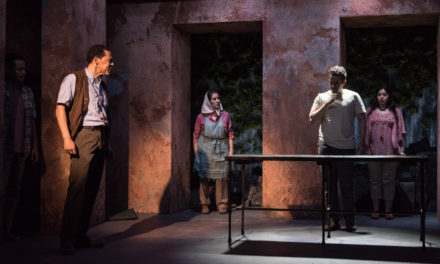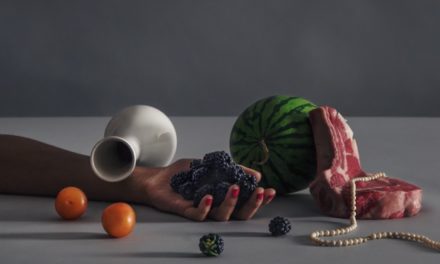The legacy of rap in America is rich with rhymes and rhymers that challenge institutionalized racism, poverty, and policing, alongside works that champion violence, explicit misogyny, and homophobia. As a form, it isn’t a monolith and playwright Idris Goodwin, with his “break beat” play series, has spent the last few years dissecting and celebrating the vastness of this genre as well as its place in the creation of American culture. Hype Man, making its premiere with Company One at the Boston Center for the Arts, is the third in this series about rap’s legacy. However, this is the first of Goodwin’s works that look squarely at the role racial identity and racism plays in the dissemination of this musical art form by looking at one oft-unseen (but clearly heard) instrument in the current national conversation about policing, policy, and identity: the construction of whiteness.
White consumers of hip-hop have always been the majority share of consumers of the genre, with varying statistics estimating that whites make up 70% to 60% (2004 Mediamark Research, Inc.) of the buyers of rap or hip-hop albums in the United States. Ignoring the much larger implications of having largely white music executives shape black artists working in a musical form rooted in black experience for white consumers, there could be something puzzling about why so many white consumers would be attracted to the form. In his book, Why White Kids Love Hip-Hop: Wangsters, Wiggers, Wannabes And The New Reality Of Race In America (2005) scholar Bakari Kitwana describes the appeal of hip-hop as, “a voice for the voiceless. More than just a new generation of music, hip-hop since its inception has provided young Blacks a public platform in a society that previously rendered them mute. It has done the same for youth of other cultures as well” (xiii). It also explains the international appeal of hip-hop. While in Russia two years ago, I would find myself in conversations with young Muscovites about their favorite Jay Z or Biggie track, what hip-hop meant to them, and the burgeoning Russian rap scene (note: rhyming rap in Russia is rare because of the challenging nature of the Russian language but it is still energetic, fun, and socially conscious nonetheless.) The “voiceless” finding its sound through the protest, anger, or joy in hip-hop undergird much of Goodwin’s “beat break” plays but is especially clear in Hype Man.
This play chronologically follows Idris Goodwin’s How We Got On (2012 premiere at the Actors Theatre of Louisville) which was a coming-of-age story about rap in the 1980s and The REALNESS (2016 premiere at Merrimack Repertory Theatre), which looked at the volatile years of 1996 and 1997, when both Tupac Shakur and Christopher Wallace, aka Biggie Smalls, were gunned down months apart from one another. Characters and location are different from the previous “break beat plays” but thematically the work matures into the inner workings of an up-and-coming rap trio. Pinnacle, a white rapper (played by Boston-native Michael Knowlton) has been making rhymes all his life, finding solace in the surrender to an art form that can channel his rage and confusion, while fortunately forging a new career for himself. His black hype man, Verb (Boston-based performer/educator and composer of the music in Hype Man Kadahj Bennett) has been along for the ride since their youth. Together with their fresh black female DJ/producer Peep One (Rachel Cognata, seen in Company One’s Really last season), the trio is beginning to hit its stride, readying a performance for the Tonight Show. Their work becomes complicated when the shooting of an unarmed black teenager by police propels Verb into action towards artistic protest, while Pinnacle chooses to stay silent and not ruffle any feathers along their flight to fame. What Peep One wants out of this, other than a solid career in hip-hop, is unclear; being a woman in such a male-dominated field seems to be work enough for her. The long-time friendship between Pinnacle and Verb begins to strain under the pressure of this conflict, especially when Verb makes a very public protest that enrages Pinnacle. Beneath this fissure emerges a complex web of power structures that highlight the tensions of race, poverty, and sudden fame in the world of Hype Man.
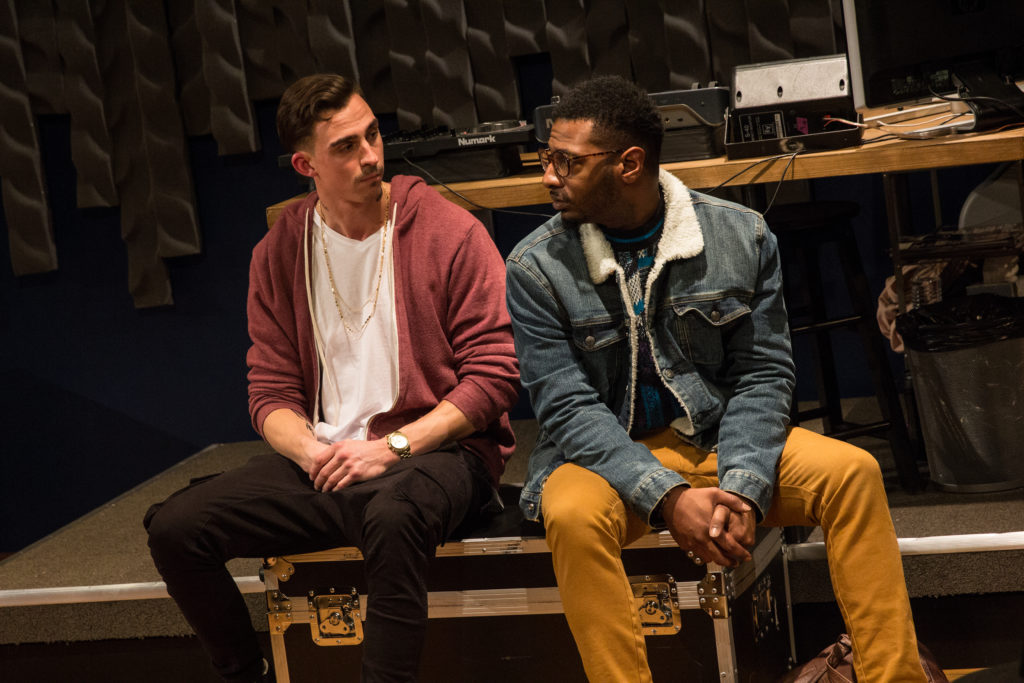
Michael Knowlton and Kadahj Bennet in Company One’s Hype Man. Photo by Paul Fox
Goodwin’s script and director Shawn LaCount’s deft hand, crafts a lived-in world for Pinnacle and Verb, giving the men subtle verbal and emotional shorthand that indicates a long history. And though Peep One is given a lot of stage time and relays important points about female producers in hip-hop, she feels the most distant in a story about identity and political art. There is a lot more to flesh-out about women and hip-hop but this is not really the focus of Hype Man; the intersectional identities of race, poverty, and maleness become the play’s clearest dramaturgical frameworks. As the story races towards its conclusion, Pinnacle’s identities of poverty and whiteness find themselves in deep conflict with Verb’s identities of poverty and blackness, with Pinnacle sometimes seeming terribly obtuse concerning the weight that institutional racism bears on people of color—especially black people in America today. In the ascent to hip-hop stardom, Pinnacle sees fame as the means to slough-off the shackles of poverty and attain a step into further privilege. Oblivious that fame can never truly change the calculus of Verb’s blackness in the racist system of Trump’s (and our) United States of America, Pinnacle spends much of the latter part of the play explaining how difficult it is to be white in the very black hip-hop world. There is something to empathize with Pinnacle’s journey and dreams being hampered by being the only white guy in the rap room. At the same time, systemic racism towards people of color is continually hampering dreams, journeys, and the ability to drive a car without being gunned down by trigger-happy police, so… It is only the cleverest of writing that can have us empathize with both points of view while obviously leaning towards the latter.
Hype Man opens Company One’s nineteenth season, entitled “Amplify.” It is a season of works by and about black men, including works by Tarell Alvin McCraney (Wig Out! in April 2018) and Josh Wilder (Leftovers in July 2018). One hopes that the artistic narratives of black lives mattering continues long beyond this season. It is refreshing to see a play not only engage in the necessary criticism of racist policing and policies in America but also focus on the ability of white artists to reinforce or resist the same systems in their work. Like Pinnacle, the impulse of theater to entertain and leave the protest to the oppressed feels safe and justified, but it only serves to reinforce that system of oppression. Maybe Hype Man gives us a cue for preaching to our choirs/audiences: tell the choir that their platform is the best place to address these problems; that silence is not an option; and that an ally takes cues from the voices of the oppressed, not popular opinion. Do that and make great art at the same time. It all is possible.
This post was written by the author in their personal capacity.The opinions expressed in this article are the author’s own and do not reflect the view of The Theatre Times, their staff or collaborators.
This post was written by James Montaño.
The views expressed here belong to the author and do not necessarily reflect our views and opinions.

